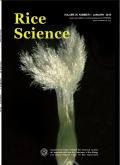Applying Boron Fertilizer at Different Growth Stages Promotes Boron Uptake and Productivity in Rice
IF 5.6
2区 农林科学
Q1 AGRONOMY
引用次数: 0
Abstract
Boron (B) is an essential micronutrient for plant growth and yield. We investigated the optimal growth stage for B fertilizer application to improve rice production. The study was conducted using a 2 × 4 factorial design in a randomized complete block during the rainy season of 2022. We utilized two premium Thai rice varieties Khao Dawk Mali 105 (KDML105) and Pathum Thani 1 (PTT1), and four soil B fertilizer treatments: a control (no B application), B application at the tillering stage, B application at the flowering stage, and B application at both the tillering and flowering stages. The results showed that the application of B fertilizer at the flowering stage and at both the tillering and flowering stages increased grain yield of KDML105 by 25.0% and 34.0%, respectively. In contrast, the grain yield of PTT1 showed no response to B application. The increased grain yield of KDML105 was attributed to an increased number of panicles per plant and a higher filled grain rate, which was due to the elevated B concentration in all plant parts and the total B uptake, particularly when B was applied at the flowering and tillering stages. Notably, B application increased the fertilized grain rates and reduced the proportion of unfertilized grains, a phenomenon that corresponded with the increased B concentration across all plant parts. The total B uptake ranged from 5.11 to 15.85 mg/m2 in KDML105 and from 8.37 to 24.26 mg/m2 in PTT1, with the highest total B uptake observed when B was applied at both the tillering and flowering stages for both rice varieties.
求助全文
约1分钟内获得全文
求助全文
来源期刊

Rice Science
Agricultural and Biological Sciences-Agronomy and Crop Science
CiteScore
8.90
自引率
6.20%
发文量
55
审稿时长
40 weeks
期刊介绍:
Rice Science is an international research journal sponsored by China National Rice Research Institute. It publishes original research papers, review articles, as well as short communications on all aspects of rice sciences in English language. Some of the topics that may be included in each issue are: breeding and genetics, biotechnology, germplasm resources, crop management, pest management, physiology, soil and fertilizer management, ecology, cereal chemistry and post-harvest processing.
 求助内容:
求助内容: 应助结果提醒方式:
应助结果提醒方式:


